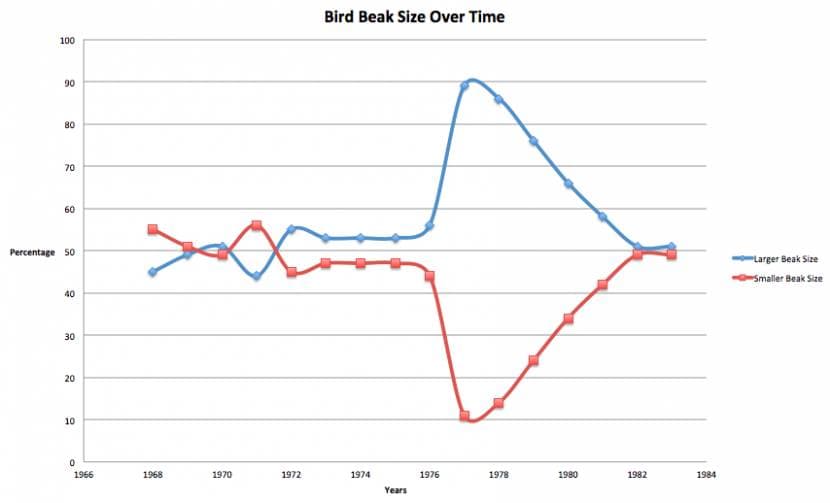Data was collected concerning Galapagos bird beak size over time. There are 13 types of Galapagos finches, and they are also known as Darwin's Finches. These finches share the same habits and characteristics except for one; they all have different beaks. The differences in their beaks might be the most important aspect of their survival because beak size determines the type of seed able to be eaten. Only the birds with the largest of beaks are able to eat the toughest, biggest, and spine covered seeds. Based on the data given, choose the BEST conclusion.
Data was collected concerning Galapagos bird beak size over time. There are 13 types of Galapagos finches, and they are also known as Darwin's Finches. These finches share the same habits and characteristics except for one; they all have different beaks. The differences in their beaks might be the most important aspect of their survival because beak size determines the type of seed able to be eaten. Only the birds with the largest of beaks are able to eat the toughest, biggest, and spine covered seeds. Based on the data given, choose the BEST conclusion.
Biology 2e
2nd Edition
ISBN:9781947172517
Author:Matthew Douglas, Jung Choi, Mary Ann Clark
Publisher:Matthew Douglas, Jung Choi, Mary Ann Clark
Chapter29: Vertebrates
Section: Chapter Questions
Problem 34CTQ: Describe three skeletal adaptations that allow for flight in birds.
Related questions
Question
Data was collected concerning Galapagos bird beak size over time. There are 13 types of Galapagos finches, and they are also known as Darwin's Finches. These finches share the same habits and characteristics except for one; they all have different beaks. The differences in their beaks might be the most important aspect of their survival because beak size determines the type of seed able to be eaten. Only the birds with the largest of beaks are able to eat the toughest, biggest, and spine covered seeds. Based on the data given, choose the BEST conclusion.
A) This data shows that over time the type of food available remained constant.
Eliminate
B) This data shows that the environment did not change over the course of time.
C) This data shows a fluctuation in bird species over time most likely due to food availability.
D) This data shows a fluctuation in bird species over time most likely due to the inheritance of acquired characteristics.
Not Graded

Transcribed Image Text:Bird Beak Size Over Time
100
90
80
70
60
Percentage 50
"Larger Beak Size
Smaller Beak Size
40
30
20
10
1966
1968
1970
1972
1974
1976
1978
1980
1982
1984
Years
Expert Solution
This question has been solved!
Explore an expertly crafted, step-by-step solution for a thorough understanding of key concepts.
This is a popular solution!
Trending now
This is a popular solution!
Step by step
Solved in 2 steps

Knowledge Booster
Learn more about
Need a deep-dive on the concept behind this application? Look no further. Learn more about this topic, biology and related others by exploring similar questions and additional content below.Recommended textbooks for you

Biology 2e
Biology
ISBN:
9781947172517
Author:
Matthew Douglas, Jung Choi, Mary Ann Clark
Publisher:
OpenStax

Health Safety And Nutrition F/Young Child
Health & Nutrition
ISBN:
9781305144767
Author:
MAROTZ
Publisher:
Cengage

Biology 2e
Biology
ISBN:
9781947172517
Author:
Matthew Douglas, Jung Choi, Mary Ann Clark
Publisher:
OpenStax

Health Safety And Nutrition F/Young Child
Health & Nutrition
ISBN:
9781305144767
Author:
MAROTZ
Publisher:
Cengage